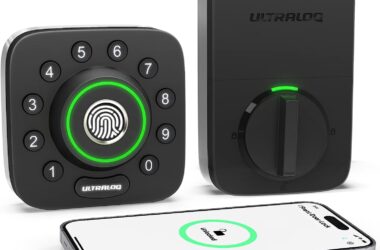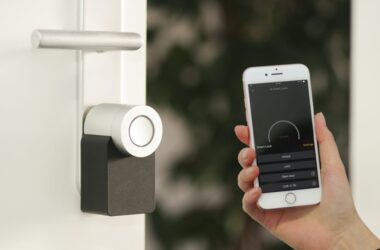Introduction
In an increasingly digital world, ensuring the safety and security of our homes is of paramount importance. Fortunately, advancements in technology have given rise to advanced home surveillance systems that provide robust protection and peace of mind. From smart security cameras to motion detection systems, these cutting-edge solutions empower homeowners to monitor their properties from anywhere, at any time. In this comprehensive guide, we will explore the realm of advanced home surveillance systems, discussing their features, benefits, and how they contribute to a safer and more secure living environment.
The Evolution of Home Surveillance Systems
Over the years, home surveillance systems have undergone a remarkable transformation, evolving from simple, manual security measures to sophisticated, high-tech solutions that provide comprehensive protection for our homes. Understanding the historical development of these systems helps us appreciate the advancements that have made modern surveillance technologies so effective.
In the early days, home security primarily relied on physical barriers such as fences, locks, and guard dogs. While these methods were effective to some extent, they were limited in scope and required a significant amount of manual monitoring. As technology progressed, so did the methods used to secure our homes.
The advent of closed-circuit television (CCTV) systems in the mid-20th century marked a significant turning point in home surveillance. These systems utilized analog cameras connected to a central monitoring station, allowing for real-time observation of designated areas. However, these early CCTV systems were bulky, expensive, and required extensive wiring, making them inaccessible for the average homeowner.
With the rise of digital technology in the late 20th century, home surveillance systems entered a new era. The transition from analog to digital cameras brought about substantial improvements in image quality and storage capabilities. Digital systems enabled the recording and storage of video footage, eliminating the need for constant live monitoring and allowing for later review.
The integration of the internet and networking technologies further revolutionized home surveillance systems. IP cameras, also known as network cameras, emerged as a game-changer in the industry. These cameras could be connected to a home network, allowing users to access live video feeds and recordings remotely via the internet. This breakthrough provided homeowners with the ability to monitor their properties from anywhere in the world, using their computers or mobile devices.
As advancements continued, wireless technologies became more prevalent, eliminating the need for extensive wiring during installation. Wireless cameras, powered by batteries or connected to a Wi-Fi network, offered increased flexibility in terms of camera placement and reduced installation costs.
The introduction of motion detection technology added another layer of intelligence to home surveillance systems. Cameras equipped with motion sensors could detect movement and trigger alerts, ensuring that homeowners were promptly notified of any suspicious activity. This advancement significantly reduced false alarms and enhanced the overall efficiency of surveillance systems.
The integration of artificial intelligence (AI) and machine learning algorithms into home surveillance systems marked yet another milestone. AI-powered cameras can now distinguish between people, pets, and objects, allowing for more accurate motion detection and reducing false positives. Facial recognition technology has also made significant strides, enabling cameras to identify known individuals and provide customized alerts and access controls.
Understanding Advanced Home Surveillance Systems
To fully appreciate the capabilities and benefits of advanced home surveillance systems, it’s essential to have a comprehensive understanding of the various components and technologies that make them so effective. At the heart of these systems are high-definition security cameras that capture clear and detailed video footage. These cameras utilize advanced image sensors and lenses to provide sharp and vivid images, even in challenging lighting conditions. Additionally, many advanced surveillance systems feature motion detection capabilities, which allow cameras to sense movement and trigger alerts. This feature helps reduce false alarms and ensures that homeowners are promptly notified of any suspicious activity. Moreover, wireless connectivity has become a standard feature in these systems, allowing for seamless integration into existing home networks. This connectivity enables users to access live video feeds and recordings remotely through dedicated apps or web interfaces. Some advanced systems also incorporate cloud storage, providing a secure and convenient way to store and access recorded footage from anywhere, without the need for physical storage devices. With the advancements in artificial intelligence, surveillance systems can now analyze video footage in real-time, enabling features such as object recognition, facial detection, and even person tracking. These intelligent capabilities further enhance the effectiveness of home surveillance systems, making them more proactive and efficient in protecting our homes. Overall, advanced home surveillance systems bring together cutting-edge technologies to provide homeowners with a comprehensive and reliable means of monitoring and securing their properties.
Benefits of Advanced Home Surveillance Systems
Advanced home surveillance systems offer a wide range of benefits that go beyond simple security measures. These sophisticated technologies empower homeowners with enhanced monitoring capabilities, peace of mind, and a proactive approach to safeguarding their homes. Let’s explore some of the key benefits that advanced home surveillance systems provide:
- Deterrence of Intruders: One of the primary benefits of advanced surveillance systems is their deterrent effect on potential intruders. Visible security cameras act as a powerful deterrent, signaling to would-be criminals that the property is monitored and protected. The mere presence of surveillance cameras can significantly reduce the likelihood of break-ins, burglaries, and other unlawful activities.
- Real-Time Monitoring: Advanced home surveillance systems enable real-time monitoring of your property from anywhere, at any time. Whether you are at work, on vacation, or simply in another room, you can access live video feeds through your smartphone, tablet, or computer. This feature allows you to stay connected and keep an eye on your home, ensuring that you are always aware of what is happening in and around your property.
- Remote Accessibility: With the integration of wireless connectivity and mobile apps, advanced surveillance systems provide homeowners with remote accessibility to their security cameras. This means you can view live feeds, review recorded footage, and even control camera settings from the convenience of your smartphone or other internet-connected devices. The ability to monitor your home remotely adds an extra layer of convenience and peace of mind, especially when you are away from home for an extended period.
- Evidence Collection: In the unfortunate event of a break-in or other security incident, advanced home surveillance systems can serve as valuable sources of evidence. High-definition cameras capture clear and detailed footage, which can be crucial in identifying suspects, documenting events, and assisting law enforcement investigations. This evidence can significantly increase the chances of apprehending criminals and recovering stolen property.
- Enhanced Safety for Loved Ones: Home surveillance systems not only protect your property but also ensure the safety of your loved ones. With the ability to monitor live feeds, you can keep an eye on children, elderly family members, or pets while you are away. This feature provides peace of mind and allows you to respond promptly in case of emergencies or unexpected situations.
- Integration with Home Automation: Advanced surveillance systems can be seamlessly integrated with existing home automation setups, creating a comprehensive security ecosystem. Integration with smart devices such as door locks, lighting systems, and motion sensors allows for enhanced coordination and automation. For example, you can configure your surveillance system to trigger specific actions, such as turning on lights or locking doors, based on detected motion or specific time schedules.
- Intelligent Alerts and Notifications: Many advanced surveillance systems employ intelligent algorithms to analyze video footage and generate relevant alerts and notifications. These systems can distinguish between routine activities and suspicious events, sending you instant alerts for potential threats. Intelligent alerts minimize false alarms and ensure that you are promptly notified of any unusual activities, allowing for timely response and intervention.
- Peace of Mind: Ultimately, the greatest benefit of an advanced home surveillance system is the peace of mind it brings. Knowing that your property is under constant surveillance and that you have the ability to monitor it remotely provides a sense of security and reassurance. Whether you are at home or away, you can have confidence in the safety and well-being of your home and loved ones.
Choosing the Right Advanced Home Surveillance System
Selecting the right advanced home surveillance system is crucial to ensure optimal security and functionality for your property. With a myriad of options available in the market, it’s essential to consider several key factors to make an informed decision. Here are some important considerations when choosing the right advanced home surveillance system:
- Property Size and Layout: Start by assessing the size and layout of your property. Determine the number of areas you want to monitor and identify any specific surveillance needs, such as indoor coverage, outdoor monitoring, or monitoring of specific entry points. This evaluation will help you determine the number of cameras and the type of system that best suits your requirements.
- Camera Resolution and Quality: Look for high-definition (HD) or ultra-high-definition (UHD) cameras to ensure clear and detailed video footage. Higher resolution cameras capture finer details, making it easier to identify faces, license plates, or other crucial elements in recorded footage. Consider cameras with features like night vision capabilities, wide-angle lenses, and adjustable angles for optimal coverage.
- Wired or Wireless System: Decide whether you prefer a wired or wireless surveillance system. Wired systems provide a reliable and consistent connection, but require professional installation and extensive wiring. On the other hand, wireless systems offer greater flexibility in camera placement, easy installation, and reduced dependence on physical connections. However, wireless systems may be susceptible to signal interference and require strong Wi-Fi coverage for optimal performance.
- Storage and Data Management: Consider how the system handles data storage. Traditional systems may utilize on-site digital video recorders (DVRs) or network video recorders (NVRs) to store footage locally. Alternatively, some advanced systems leverage cloud-based storage, allowing you to access recorded footage from anywhere, eliminating the risk of physical damage or theft of storage devices. Evaluate storage capacity, accessibility, and any associated costs for long-term storage or additional cloud storage plans.
- Integration and Expandability: If you have an existing home automation system or plan to integrate one in the future, ensure compatibility and seamless integration with your advanced surveillance system. Look for systems that support industry-standard protocols like ONVIF or have compatibility with popular home automation platforms. This integration enables you to create a unified and centralized control system for your entire home security infrastructure.
- Remote Access and Mobile App: Check for the availability of a user-friendly mobile app or web interface that allows you to remotely access and control your surveillance system. The app should provide live video feeds, enable playback of recorded footage, and offer customizable settings and alerts. Consider the app’s user ratings, compatibility with your mobile device, and the ease of use when evaluating different systems.
- Budget Considerations: Determine your budget for an advanced home surveillance system, considering both the initial investment and any ongoing costs such as cloud storage subscriptions or maintenance fees. While it’s tempting to opt for the cheapest option, prioritize quality, reliability, and features that align with your specific security needs. Remember, investing in a robust and reliable system will provide long-term benefits and peace of mind.
- Reviews and Recommendations: Research customer reviews, testimonials, and expert opinions on different surveillance system brands and models. Online forums, technology publications, and customer feedback can provide valuable insights into the performance, reliability, and customer support of various systems. Pay attention to any recurring issues or praises that may help inform your decision-making process.
Best Practices for Installing and Maintaining Home Surveillance Systems
Installing and maintaining your home surveillance system properly is essential to ensure optimal performance and longevity. By following best practices, you can maximize the effectiveness of your system and enjoy the peace of mind it provides. Consider the following guidelines for installing and maintaining your home surveillance system:
- Strategic Camera Placement: Carefully consider the placement of your cameras to achieve optimal coverage. Install cameras at key entry points, such as doors, windows, and driveways, to capture crucial footage. Ensure cameras are positioned at an appropriate height and angle to capture clear images and minimize blind spots. Test camera views before finalizing their placement to confirm that they cover the desired areas effectively.
- Proper Camera Positioning: Adjust camera settings to optimize image quality and minimize false alerts. Set the focus, exposure, and motion detection sensitivity based on the specific environment and lighting conditions. Avoid pointing cameras directly at bright light sources, as it may impact image quality. Regularly review camera angles and readjust as needed to accommodate changes in the landscape or surroundings.
- Secure Mounting and Protection: Ensure that cameras and mounting brackets are securely installed to prevent tampering or unauthorized removal. Use appropriate tools and mounting hardware for the specific camera and mounting surface. Consider weatherproof or vandal-resistant cameras for outdoor installations to protect them from the elements and potential tampering. Regularly check camera housing for any damage and promptly address any issues to maintain functionality.
- Quality Cabling and Connections: If you are using a wired surveillance system, use high-quality cables and connectors for reliable transmission of video signals. Opt for cables specifically designed for surveillance applications, such as RG59 or RG6 coaxial cables. Properly terminate connections and use weatherproofing techniques when necessary, especially for outdoor installations, to protect against moisture and corrosion.
- Regular System Maintenance: Perform regular maintenance tasks to ensure the continued functionality of your surveillance system. Regularly clean camera lenses and housings to remove dirt, dust, and debris that may impair image quality. Inspect cables, connections, and power supplies for any signs of wear or damage. Check system logs and storage capacity to ensure smooth operation and make necessary adjustments or upgrades as needed.
- Firmware Updates: Keep your surveillance system up to date by regularly checking for firmware updates from the manufacturer. Firmware updates often include security patches, bug fixes, and performance improvements. Follow the manufacturer’s instructions for updating firmware and ensure compatibility with your system components.
- Monitor System Health: Periodically review system logs and notifications to ensure that all components are functioning properly. Regularly check for any error messages or unusual behavior, such as camera malfunctions or network connectivity issues. Address any issues promptly, whether it requires troubleshooting on your own or seeking professional assistance.
- Test and Evaluate: Routinely test your surveillance system to ensure that all cameras, sensors, and other components are working as intended. Conduct test recordings, review playback, and verify that motion detection settings are accurately capturing events. Regularly evaluate the performance of your system and make necessary adjustments or upgrades to improve its effectiveness.
Future Trends in Advanced Home Surveillance Systems
The world of advanced home surveillance systems continues to evolve rapidly, driven by technological advancements and innovative solutions. As we look to the future, several trends are shaping the landscape of home security and paving the way for even more sophisticated and effective surveillance systems. Let’s explore some of the exciting trends that we can expect to see in advanced home surveillance systems:
- Facial Recognition and Person Identification: Facial recognition technology is becoming increasingly accurate and reliable. Future surveillance systems will leverage facial recognition algorithms to identify known individuals and distinguish them from potential threats. This feature will enable homeowners to receive customized alerts when recognized individuals are detected and provide an additional layer of security.
- Artificial Intelligence and Deep Learning: The integration of artificial intelligence (AI) and deep learning algorithms will revolutionize home surveillance systems. These advanced algorithms can analyze video footage in real-time, allowing for more accurate object recognition, activity detection, and behavioral analysis. AI-powered systems will be able to differentiate between normal activities and suspicious behavior, minimizing false alarms and improving overall system efficiency.
- Smart Analytics and Predictive Insights: Surveillance systems of the future will incorporate smart analytics capabilities to provide predictive insights and proactive security measures. By analyzing historical data and patterns, these systems can identify potential security risks and vulnerabilities. Homeowners will receive proactive alerts and recommendations to address these risks, helping to prevent security breaches before they occur.
- Integration with Internet of Things (IoT) Devices: As the Internet of Things (IoT) continues to expand, we can expect advanced home surveillance systems to integrate seamlessly with other smart devices within the home. This integration will enable enhanced automation and coordination among security cameras, smart locks, lighting systems, and other IoT devices. For example, when a surveillance camera detects motion, it can trigger the lighting system to turn on, deterring potential intruders.
- Cloud-Based Surveillance and Storage: Cloud technology will play a pivotal role in the future of home surveillance systems. Cloud-based surveillance solutions offer convenient and secure storage of video footage, eliminating the need for physical storage devices and providing seamless access to recordings from anywhere. This scalability and flexibility allow homeowners to expand their storage capacity as needed without the constraints of physical infrastructure.
- Advanced Biometric Authentication: Biometric authentication methods, such as fingerprint scanning or voice recognition, will enhance access control and security in home surveillance systems. By incorporating biometric authentication, homeowners can ensure that only authorized individuals have access to the surveillance system and its associated features. This additional layer of security will further protect sensitive data and prevent unauthorized access.
- Enhanced Privacy and Data Protection: As surveillance technology advances, so does the need for privacy and data protection. Future systems will prioritize robust encryption protocols, secure authentication mechanisms, and privacy controls. Homeowners will have greater control over their data, with options to customize privacy settings and comply with evolving regulations.
- Augmented Reality (AR) Integration: Augmented reality technology has the potential to revolutionize the way we interact with home surveillance systems. Users may be able to overlay real-time video feeds onto a digital map of their property, providing a more immersive and intuitive monitoring experience. AR integration can enhance situational awareness, allowing homeowners to quickly identify the location of potential threats and take appropriate action.
As these trends continue to shape the future of advanced home surveillance systems, homeowners can expect more intelligent, intuitive, and integrated security solutions. The convergence of AI, IoT, cloud technology, and advanced analytics will redefine how we protect our homes, providing enhanced security, automation, and peace of mind. Embracing these emerging trends will empower homeowners to stay one step ahead in an ever-changing security landscape.
Conclusion
In conclusion, advanced home surveillance systems have revolutionized the way we safeguard our homes. With their advanced features, seamless integration capabilities, and real-time monitoring, these systems offer unparalleled security and peace of mind. By understanding the evolution, components, benefits, and best practices associated with these systems, homeowners can make informed decisions to protect their most valuable asset—their home. Embrace the power of technology and take control of your home security today.
We hope you found this comprehensive guide to advanced home surveillance systems informative and insightful. As technology continues to advance, it’s crucial to stay informed about the latest trends and innovations in home security. We’d love to hear your thoughts and opinions on this topic. Do you currently use an advanced surveillance system? Are there any specific features or trends that excite you? How do you feel about the future integration of AI, facial recognition, or cloud storage in home surveillance systems? Please share your thoughts and experiences in the comment section below. Your valuable insights can contribute to a meaningful discussion and help fellow readers make informed decisions about their home security.









